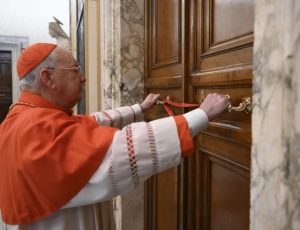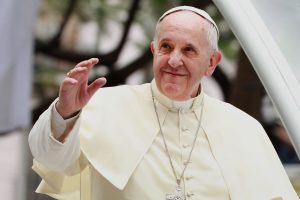Pope Francis was revered for his humble lifestyle and uncomplicated way of life, yet his death triggered a succession of old and nearly inexplicable rites.
One of the first? His flat was sealed almost immediately, and the cause is more intriguing than you might assume.
Following Pope Francis’ death on Monday, Catholics worldwide are mourning the loss of their spiritual leader.
The Pope died of a stroke at the age of 88.
When a pope dies, a highly precise and tradition-bound process begins in the Vatican. For example, on Tuesday, the Vatican revealed the first striking photographs of Pope Francis lying in repose, providing a solemn peek into the hallowed rites commemorating his life.
In the photographs, his open casket is ringed by ceremonial guards as Vatican officials and members of his family come to say their final goodbyes. Francis is wearing in red vestments, which represent martyrdom and Christ’s blood, and has a rosary lovingly placed in his folded hands.
A silk cord is tied over the door.
Following the Pope’s death, senior Vatican officials sealed and locked his personal residence on Monday.
The sealing takes place soon following the Pope’s death or resignation. It is carried out in the presence of the Vice-Camerlengo, Archbishop Ilson de Jesus Montanari. A silk cord is tied across the entrance and fastened with a wax seal, leaving the interior unharmed. The unbroken seal provides confirmation that no one has entered.

The room will only be reopened and the seal released once the conclave is completed and a new Pope is elected.
According to CBS News, Pope Francis has decided not to live in the traditional papal apartments in the Apostolic Palace. Instead, he lived in a humble room at Casa Santa Marta, the Vatican’s guesthouse, which is more of a dorm-style setup.
“He lives in a small room,” said Lucas Schaerer, a Vatican insider who became friends with Pope Francis in 2008, in a 2015 People interview.
Why was Pope’s flat sealed?
So, why was the Pope’s house sealed off at all? While the practice may appear to be purely symbolic—especially given Pope Francis’ decision to live in the humble quarters of the church guesthouse, Casa Santa Marta, rather than the customary Apostolic Palace—it also has a functional purpose.
According to Sky News, the practice began as a measure to “prevent looting” after a pope died.
But, more crucially, it helps to prevent tampering with papal documents or the unauthorised publication of items that can only be handled by the future pope. To assure this, the sealing is performed by a Roman Curia official known as the Camerlengo, or Chamberlain, who is now Cardinal Kevin Farrell, who also serves as the head of the Vatican’s Dicastery for the Laity, Family and Life.
Another ritual.
As the Catholic Church prepares for funerals and commemoration rites, attention has turned to Pope Francis’ iconic Fisherman’s Ring from his presidency.
The ring’s true significance extends far beyond its material value, which is estimated to be around $520,000. The signet ring is a symbol of the papacy, representing the pope’s authority within the Catholic Church.

Traditionally, the ring is given to a newly elected pope and then burned upon their death. This liturgy is performed by the camerlengo (Cardinal), who in this case is Cardinal Kevin Farrell. The destruction ensures that the ring cannot be misused after the pope’s death, as it was originally created as a seal for the pope’s personal letters, but it now serves ceremonial purposes.
The ring and its accompanying bulla (papal seal) are destroyed in front of the College of Cardinals once the pope’s death is officially confirmed, immediately before the papal conclave begins to elect a new pope.
The Vatican has confirmed that Pope Francis’ funeral will be held on Saturday, April 26 at 10 a.m. local time in St. Peter’s Square.
Following the public service, his body will be carried to the Basilica of Santa Maria Maggiore in Rome’s Esquilino neighbourhood, where Francis once expressed his desire to be placed to rest.
